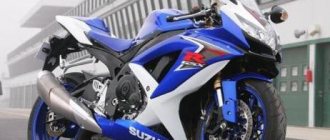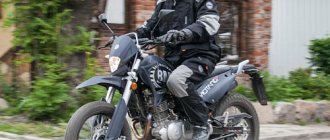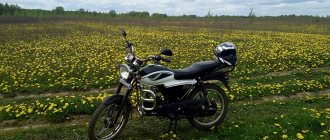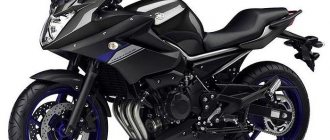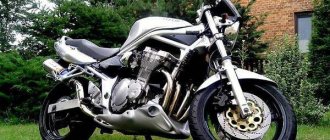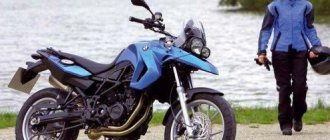Pit bikes allow you to try your hand at rough terrain. These are “miniature” motocross bikes, that is, their size is much smaller. They are suitable for both children and adults. For European countries they are commonplace. In our country, few people know about them, and even fewer have ever ridden them. A prominent representative of this category of motorcycles is the Kayo 140 pit bike. It is used to participate in various kinds of competitions (supermoto, motocross, stunt riding), enduro rides, or simply during outdoor recreation.
Manufacturer
In the nineties of the last century, a new one opened in China. And he was engaged in the production of small bikes (pit bikes). In the early years, the company produced about thirty thousand models per year. Over time, he became one of the leaders in the production of this type of motorcycle. The manufacturer offers twenty-five models of motorcycles.
The company's products have always been distinguished by affordable prices. And for the budget price category, Kayo 140 pit bikes are of good quality. Of course, there are also disadvantages. But with proper operation and timely technical inspection, the bike can last a long time. Before starting operation, immediately after purchase, it is necessary to check the quality of all components of the motorcycle. If necessary, tighten loose fasteners.
Kayo products can compete with products from European manufacturers in terms of such characteristics as controllability, build quality, ease of operation, inexpensive maintenance and repairs.
Frame
The frame of the Kayo-140 pit bike is presented in the form of tubular steel profiles. The method of mounting the engine is interesting. It does not lie on the frame, but is suspended from below.
As for the steering column, it also has its own characteristics. Its angle of inclination is sharper than that of other models in this class. Due to this, maneuverability and road stability have improved.
The design of the bike includes plastic inserts. It is worth noting that this material is of high quality. It is flexible and soft enough not to break at the slightest impact.
Test drive Kayo125 WildCat, Kayo140 CraZyCat, Kayo150 VorteXCat
Pit bikes, which have become incredibly widespread abroad, are for some reason considered an “unseen animal” in the vastness of our homeland. This technique is a smaller copy of a cross bike, which is equally convenient for both children and adults. The scope of application of pit bikes is extremely diverse: motocross, stunt riding, supermoto and enduro. Well, let's meet three representatives of this class.
My first acquaintance with this technique took place via the Internet. Looking at the nice photographs of this “miracle”, I still had little idea of the dimensions of the pit bike, and even more so, its behavior under the yoke of the 85-kilogram “carcass” of the tester. However, interest was born even then.
I was able to test three models of the same brand: Kayo 125 WildCat, Kayo 140 CraZyCat and Kayo 150 VorteXCat. As the names suggest, they have engines of 125, 140 and 150 cubic centimeters, respectively. Actually, this is their main difference, because the chassis of pit bikes is almost the same.
They are based on a spatial tubular steel frame with a very decent quality of welds and a competent design (probably copied from European pit bikes). The front suspension is an adjustable (!) upside-down fork, and at the rear there is a cast aluminum swingarm, which is supported by a monoshock absorber. The latter, by the way, has an adjusting washer for adjusting the preload of the spring. In addition, pit bikes come standard with brake, clutch and gearbox levers that fold when dropped, which significantly extends their service life in conditions of frequent falls. “Pleasant little things” also include thick white vinyl stickers on the plastic, which are located in places where there is likely to be contact with the “underlying surface,” silicone steering wheel grips and a valve cap on the gas tank cover, which prevents gasoline from leaking out during falls.
I decided to start with the younger, 125 cc model. Contrary to my fears, the pit bike started from the very first push of the kickstarter. Wow, the sound is clearly not relative to the engine size. Not constrained by legislative standards for noise and exhaust toxicity, the Chinese bolted a direct-flow exhaust system onto the pit bike! That’s why this “octagon” sounds no worse than a cross-country 450 (adjusted for decibels).
Sitting behind the wheel, I felt quite at ease. The ergonomics of the driver's seat are clearly designed for an adult, as is clearly demonstrated by the seat height, which is 835 mm!
I squeeze the clutch, press the gearshift foot... and stand still. It turned out that the gears on these pit bikes are switched according to the N-1-2-3-4 pattern (instead of the usual 1-N-2-3-4). I would not call such a technical solution successful. Just imagine: you approach a corner of a cross-country track at good speed, shift down gears, but miss the first gear, ending up in neutral. As a result, instead of sharp acceleration after the apex and a fountain of earth from under the rear wheel, the pit bike only “idles” scares the area with a loud roar. In addition, “catching neutral” in a static position on the Kayo 125 is an activity for puzzle lovers. Well, that’s why it’s the cheapest in the series.
So, having more or less figured out the checkpoint, I started. The first gear seemed too short to me, but on reflection, I decided that this was still a plus. With such a gear ratio, even a motor that is not related to Hercules can develop decent traction. For example, in order to drag an 85-kilogram pilot up a long steep slope.
Having escaped into the “operational space,” I unscrewed the gas handle and, clicking through the gears, began to accelerate.
Two-valve four-stroke engine that produces 8.3 hp. at 7500 rpm, it demonstrates good torque at low and medium speeds, but is “specifically blunt” at the “top”. Therefore, I didn’t want to experiment with maximum speed (and even on icy primers). Despite its small size, the pit bike accelerates quite quickly, but you can guess for yourself what the consequences of falling off-road, and even at a speed of about 50-60 km/h, are.
The pendant left a pleasant impression. Frankly, at first I thought that it served a purely decorative function here, but the front fork and rear monoshock absorber turned out to be fully functional! Their energy intensity is enough to withstand impressive jumps or rush along the “washboard” without slowing down at the “cruising” speed of 50-60 km/h. And for off-road use this is a lot. In any case, much more than 120 on asphalt. However, it was not without its drawbacks. In contrast to the well-functioning front fork (adjusted for the oil thickening due to cold weather), the rear suspension works “so-so”, as a result of which the pilot sometimes does not understand what is happening with the rear wheel.
But the hydraulic brakes do not cause any complaints. For a 71-kilogram device with a “maximum speed” of 80 km/h, their efficiency is enough “for the eyes.” However, if you put a set of light-alloy road wheels on a pit bike and put them on slicks, then even in this case the performance of the standard braking system of the newly-minted minimotard will be more than enough.
Leaving the 125 to cool down to the sound of the clicking air vent, I switched to the 140 cc model. This pit bike has a slightly different frame design, different forms of plastic lining and a creative white and green coloring. By the way, the plastic on all three models turned out to be “correct”. It is soft and very flexible, that is, it does not break when dropped.
CraZyCat is 20 mm shorter and the same 20 mm lower than its brothers, but this difference remains only on paper. Looking ahead, I will say that while driving I did not notice any differences between them in ergonomics and handling. The Kayo 140 engine is another clone of the Honda Super Cub engine. This power unit produces almost 10 hp. at 8000 rpm, and is therefore equipped with an oil cooler.
Despite my remaining doubts, the engine also started on the first “kick”, filling the surrounding area with a deep roar. Having clicked the gearshift foot in a static state, I was surprised to find that all gears were switched clearly, and neutral was caught “on time”.
Thanks to the short first gear, careless handling of the throttle can result in the Kayo 140 CraZyCat getting into a wheelie, or even throwing off the slob pilot. Well, let's take it into account. Due to the faster engine and clear gearbox, this pit bike is perfect for all sorts of reckless activities. As I circled around the area, I dreamed of going to an indoor BMX park. It was there, on trampolines of various configurations, that one could have a real blast.
The 140 cc power unit works, how shall I put it... more expressively than the “125”. It follows the throttle better and has more impressive traction throughout the entire rev range.
Having ridden the Kayo 140 to my heart's content, I switched to the 150 cc VorteXCat, which, with the exception of the engine, is a copy of the 125 cc WildCat. But when designing the motor, the designers did not limit themselves to simply increasing the working volume. They also increased the compression ratio, thanks to which the engine began to produce 13.6 hp. at 9500 rpm, and 11.2 Nm at 7500 rpm. And if you also remember that the dry weight of the pit bike remained at 71 kg, then you can guess that the Kayo 150 will “make” the same Yamaha YBR-125 and other road motorcycles of similar cubic capacity from the start. As expected, the engine started easily. This pit bike has an even sharper exhaust “voice” than its “younger” brothers. Well, let's see how he is in business.
I engage first gear, release the clutch and... gas, gas! The pit bike rushed forward, throwing out a fountain of melted snow and dead grass from under the rear wheel. The Kayo 150 motor is even more playful and spins up faster. Perhaps this device comes closest to KTM minicross motorcycles and Polini pit bikes. The positive impression of the engine is enhanced by a clearly operating gearbox with a well-catched neutral. Due to the higher degree of compression, the power unit has lost a little in elasticity compared to the 140 cc model, but at the “top” it shows a more evil disposition.
The controllability of all three fully deserves the epithet “bicycle-like” - Kayo is able to turn around on a spot with a diameter of just over a meter, and literally the power of thought is enough to change the trajectory. When I put the pit bike into a power drift to the delight of the photographer, I felt unprecedented confidence. Thanks to its low weight and low seat height, a pit bike will forgive many piloting mistakes, and maybe even teach you something. Apparently, it’s not for nothing that “bourgeois” motorcycle schools begin teaching the art of stunt riding with just such a technique.
I believe that if pit bikes could be adapted for use on public roads, they would become a bestseller among active, uncomplicated youth. Having a low cost, light weight, a peppy engine and excellent handling, such devices would be an excellent alternative to other urban transport.
However, even under the current situation, such devices are an excellent means for active recreation and amateur motorsports.
Completing the test drive, I was finally able to unequivocally answer the traditional question: “would you like to see such equipment in your garage?” So as I write this, the white and green Kayo 140 CraZyCat is preparing to take pride of place in the pit next to my KTM 990 Adventure.
Text: Sergey Kuznetsov
Photo: Andrey Shlenchak
Test equipment provided by:
Mototech.Kiev.Ua
Kiev-Svyatoshinsky district, village. Gurovshchina
(Kyiv-Zhitomir highway, 31st kilometer)
Bike control
The dashboard of the Kayo-140 mini-motorcycle is simple. It is devoid of unnecessary sensors and buttons. There is only one gauge indicating the engine hours.
Standard set of handles. They all add up. In case of an accident they will not break.
On the left side of the steering column there is a button to switch the lights. Nearby is the engine start (starter) button. The classically shaped handle is also a clutch. The gas and brake are connected to the right handle.
Power unit
Kayo 140, the technical characteristics of which may surprise you, is equipped with an engine with a displacement of 140 cubic centimeters. Its power is slightly higher than that of models in this class. The engine produces fourteen horsepower at eight thousand rpm. This engine is a converted version of the well-known Honda Super Cub engine.
The engine is four-stroke. Fuel is supplied via a carburetor. The downside of the fuel system is the lack of a fuel filter. Manufacturers considered this part unnecessary. But if you refuel your bike from a canister, you can’t do without a fuel filter. Some amateurs install it immediately after the tank.
Kickstarter will help you start a pit bike. Air-oil cooling of the engine will prevent it from overheating.
KAYO 125cc pit bikes
Three more motorcycle models are no less playful and agile than their “bigger brothers”: KAYO CRF801-7L Basic 17/14 KAYO CRF801-7L Classic 14/12 KAYO CRF801-7L Classic 17/14
Like the previous three classes of sports bikes, they have many similarities. These three motorcycles are equipped with steel rims, swingarms and handlebars. All have the same 4-stroke 125cc engine. Like the 140 cc motorcycles that were reviewed earlier, these three motorcycles differ from each other only in tires (the KAYO CRF801-7L Classic 14/12 model has smaller ones, which is actually clear even from the name), and the remaining two pit bikes are shod "in already typical tires: 14 inches at the rear and 17 inches at the front. That is, with regard to the engine, ignition, shock absorbers and suspensions, this is actually the same bike model without any differences. And now about the main difference - about accessories. Being a basic 125 cc model, KAYO CRF801-7L Basic 17/14 contains a minimal package that does not include accessories that provide the driver with additional convenience and utility. For example, this motorcycle does not have an ignition switch, which is installed in two other, more advanced bikes in this regard. This motorcycle does not have an hour meter, which is available in the other two pit bikes. An interesting fact is that the KAYO CRF801-7L Classic 14/12 motorcycle has a headlight installed by the manufacturer. That is, it can already be used as a regular vehicle for traveling in the dark.
And now a few words about the only “sports moped” that perfectly complements the variety of motorcycles in the KAYO collection. Let's start with the fact that with a cylinder volume of 49 cm3. he weighs only 56 kilograms. A kind of small and lightweight sports moped, which is a smaller copy of its older pit bike brothers. For a teenager this is it. Yes, and it is advanced - it is equipped not only with a kickstarter, but also with an ignition switch with an electric starter, as befits a respectable motorcycle. The wheels are steel rims with 10-inch tires - a typical moped design.
Transmission
The Kayo 140 pit bike is equipped with a manual transmission with four gears. Speeds change easily and clearly. Finding neutral gear is not difficult; usually it is caught the first time. A special feature of the gearbox is its very short first speed.
The gearbox is driven by a chain drive. It would seem that a chain is more reliable than a belt. But it's not that simple. This model uses a 420 chain. During the operation of the bike, it periodically stretches. Therefore, its service life is short.
Main Dimensions
The Kayo 140 pit bike has the following dimensions:
- Wheelbase - 1.23 meters.
- The height of the saddle is 0.89 meters.
The weight of this vehicle is 71 kilograms.
The wheels are different. The front ones are seventeen inches in diameter. Rear - fourteen inches.
The fuel tank capacity is five and a half liters.
Specifications
| Pitbike Kayo 140 (specifications) | Parameter |
| Engine | Single-cylinder, four-stroke YX1P56FMI engine. Air-oil cooling. |
| Carburetor | KEIHIN pz30. Air filter AIRBOX closed type. Manual transmission, N-1-2-3-4, all up. |
| Transmission | Manual transmission, N-1-2-3-4, all up. |
| Cooling | Air-oil (oil radiator under the tank) |
| Frame | A steel birdcage frame is installed. Plastic type KRZ. Plastic tank with a volume of 5.5 liters, with a reserve. |
| Suspension | Front fork without adjustments 735 mm. Rear shock absorber 360 mm with adjustable spring tension. |
| Wheel size | 17(front)x14(rear) |
| Wheels | Aluminum rims, steel hubs. INNOVA tires. Front tires 70/100-17. rear: 90/100-14. There are towing brakes on both wheels. |
| Mounted | Short-throw throttle grip with bearing, high aluminum handlebar with 22 mm jumper (bends easily), KMC 428H GOLD chain, reinforced kick starter lever, brake pedal with colored CNC overlay, new more durable seat cover material with logo, Spoke Skins on the spokes included, milled tank cover. Steel pendulum. |
| Electrics | LED headlight, 3-position ignition switch, waterproof switches on the steering wheel. Hour meter with tachometer. |
| Wheelbase | 1225 (mm) |
| Seat height | 885 (mm) |
Variety of species
The manufacturer offers several versions of the Kayo pit bike with an engine capacity of 140 cubic centimeters.
Kayo 140 Classic YX140E KRZ is one of the most popular models among users. It is characterized by a four-stroke engine with a volume of 140 cubic centimeters and a power of nine and a half horsepower. Air-oil cooling system. The gearbox is four-speed. The front fork is telescopic inverted. A monoshock absorber is installed at the rear. The weight of the equipment is 71 kilograms.
The Kayo-Basic-UH pit bike has the same engine size and type as the previous model. But the output power is already 11.2 liters. With. Air-oil cooling of the carburetor. Four-speed manual transmission. Wheels are seventeen and fourteen inches. The fuel tank has a capacity of five and a half liters, which is one liter more than the previous version.
KAYO 140cc pit bikes
Seven wonderful compact motorcycles with engine capacities of 140 cc, which are practically in no way inferior to 150 cc pit bikes, represent a worthy addition to the Kayo model range. Typical representatives of 140 cc Kayo are:
KAYO CRF801-7L Classic 12/14 KAYO CRF801-7L Classic 14/17 KAYO CRF801-7L Motard KAYO CRF801-7L Motard Classic 12/12 KAYO CRF801-7L Motard PRO 12/12 KAYO CRF801-7L Super Moto 12/12 KAYO CRF801 -7L Super Moto 14/12
All seven of these magnificent motorcycles are powered by single-cylinder, 4-stroke, air-oil-cooled engines with a displacement of 140 cc. The engine is cooled using an oil cooler, which is a more efficient method compared to conventional air cooling. Distributing these seven bikes by power, it is necessary to note that, like the “hundredty”, there are almost no significant differences between them. The engine torque of all models without exception is 9.5 Nm at a rotation speed of 5500 rpm, which is approximately 14 horses. The fuel supply (carburetor), ignition type (CDI), swingarm and steering wheel (made of steel), as well as disc brakes (aluminum) are also identical for these motorcycles. So how, exactly, do these seven sports pit bikes differ, even if the gearboxes and both suspensions of the 140 cc KAYO motorcycles are absolutely no different from each other? And if the models with 150 cc engines had at least a difference in the volume of fuel tanks, then these are all equipped with 5.5 liter tanks. fuel. Obviously, tire size and accessories are two things that make the models different from each other. Like previous motorcycles with slightly higher engine power, these pit bikes are equipped, depending on a particular model, with a set of tires 12 + 14 inches, or 14 + 17 inches, and therefore the wheelbase can be either 1210 mm or 1220 mm.
As can be seen from the technical characteristics, all seven models are essentially the same motorcycle and they differ from each other only in tire size, additional accessories and external design, which, by the way, is also not very different.
Operation and Maintenance
With proper use, Kayo 140 will last for quite a long time. But to do this, the vehicle must be monitored from the moment of purchase.
After purchase, you must carefully check all components and elements of the bike for manufacturing defects. Tighten all fasteners that need it. Running in a motorcycle must be carried out in compliance with all necessary rules. When using the bike intensively, it is necessary to change sprockets and chains regularly (once a season).
It is worth remembering that when operating a vehicle in winter conditions, special care must be taken. Decorative plastic hardens in the cold and becomes more fragile. Jumping at subzero temperatures is fraught with failure of control handles (brakes, clutch) and shock absorbers.
As for spare parts for the Kayo-140, there are no particular problems. Many details and elements are similar to other models. Therefore, if necessary, you can even replace it with parts from other bikes.
Kayo 140 Disadvantages Review
Greetings to all lovers of these wonderful mopeds! We bought 6 Kayo 140 pit bikes in the month of October with some time interval. 5 motocross bikes and 1 motard bike. Since we are cross-country athletes, the test on the old cross-country track was not long in coming. But first, a preface. Having bought mopeds and brought them to the garage, they arranged a broaching. Assembly in the warehouse depends on the mood of the sellers as well as the Chinese at their factory. We stretched everything carefully, paying special attention to the rear sprocket. Although it is tightened and locked, you will be surprised that by bending the locking you can still pull and tighten the bolts. It is very important! I strongly recommend lubricating the cables, especially the clutch. The unpleasant crunch will disappear, and it will last many times longer. Next, pay attention to the steering wheel mount; then I’ll explain why. Tighten the hex bolts harder! And so they seemed to rattle at idle, then drove around without putting much strain on the engine. Not everyone, of course, held their own here, but they more or less tried to control themselves. At 5 o'clock the correct oil was added (Motul 7100). When draining the old oil, do not forget to tilt the motor so that everything is glassy from everywhere.
1) You understand that the time of year is not hot, mopeds are in the garage and are freezing. And then it turns out that the rear shock absorbers are not working! Disappointment and that's all. First one noticed, then I did. They thought that the oil boiled because of the good springboards, they say there was not enough nitrogen pumped in. And it’s true, it’s almost nothing. We pumped what was available into one - air (with a regular compressor 3-5 atm.). It seems to have worked. But the situation repeated itself almost immediately. Symptoms - knocking on rebound, feeling as if it is only working on the spring. But it actually turned out that there was a sharp reverse stroke of 5 mm with a knock, and then the shock absorber slowly, slowly moved further. Conclusion - The oil in it is very thick... not for winter and cold weather. Once you drive for a bit, the oil warms up and the operation becomes normal. Don't overdo it when it's cold - you can ruin the shock absorption. New! We decided to deal with the problem. Pump from 10 to 20 atmospheres into the shock. They suggested that there is a pump for inflating bicycle forks/shock absorbers. We look in the store - and indeed - a high pressure pump! Up to 20 atm. As a result, we download 15 and enjoy life. Even in cold weather the work is stable. This solves the problem. We will not change the oil to a less viscous one for now. 2) Strong jumps, unsuccessful landings and your steering wheel will turn in the mounts. It will not be pleasant and unexpected. This is to what was written earlier. Pull the fastener harder. But in fact, the steering wheel is bad, the fasteners are the same. 3) The brake and clutch handles are terrible. And the fact that they fold does not save them even once. The handle breaks, there is no sense in folding it. The kit costs as much as 700 rubles and constantly changing it is not the most pleasant thing. Buy protection for the steering wheel or loosen the mount on the steering wheel - if you fall, it will turn and not break. This is a standard technique. 4) Oil cooler hose. We haven’t seen anything like this anywhere on the Internet, but it started to flow. I’ll say right away that they didn’t run into anything, didn’t pull with branches, etc. It leaked at the compression point, that is, the connection with the fitting at the end. Marriage? Perhaps the Chinese cheated. But the hose can't really be found anywhere. Either order, or make a clamp, or make to order (high-pressure hoses). A very unpleasant breakdown. 5) Chain and star. The chain is stretching quite well... I feel like some of them will have to be replaced soon. We take high-quality, famous ones. The rear sprocket, despite the plate locking of the bolts, is weakened. Apply additional Loctite... or better counter, i.e. bend the plate. 6) The muffler rattled. Many have. Namely, this is the mesh at the exit of the can. She makes a nasty rattling sound. I’ll describe the treatment option, but it’s probably not the only one. New! So, remove the muffler (can). Drill out the rivets with a suitable drill and remove the cap. We see a large ring in the shape of a can, an ordinary washer of large diameter, and then the offal (stuffing and sieve tube). At the factory, the sieve tube and both rings are welded. But it’s so bad that all this is separated from each other in a couple of hours. Conclusion: you can brew it again, but I did it differently. Threw the puck away. I found a pipe literally 5 cm long so that it would fit into the sieve pipe with a slight tension. I welded the found pipe to the Big Ring (which is shaped like a can). Further, in the cap there are directly designed ebbs for the bolts. We drill holes for a bolt with M6 thread. We also drill holes in the Big Ring and weld the nuts. Now what thundered before will hold securely. Screw it to the cap. We put it on the can and secure it with new rivets. We rejoice in the silence! 7) One of us, who loves to mix mud, had his rear wheel bearings jammed. Yes, they are a closed type, but apparently the dirt, coupled with the Chinese quality, made them malfunction... they spun hard and jammed. They replaced them with new ones bought at a car store. They come from a VAZ from somewhere. The springs of the running boards and footpegs are easily lost. The ears on the ends of the springs are weak; you need to tighten them more with pliers yourself.
Yes, they are a closed type, but apparently the dirt, coupled with the Chinese quality, made them malfunction... they spun hard and jammed. They replaced them with new ones bought at a car store. They come from a VAZ from somewhere. The springs of the running boards and footpegs are easily lost. The ears on the ends of the springs are weak; you need to tighten them more with pliers yourself.
Phew, that's it. Many or few? Everyone will evaluate it differently. We looked at it from the perspective of its intended use - a cross-country track. By the way, they jump well, the suspension takes the blow. You can, of course, be tougher, but it all depends on your skill in flying high. If the Chinese immediately supplied high-quality parts (steering wheels, chains, suspensions), then the price would increase significantly, perhaps 2 times. This is approximately how racing drinks will differ from regular ones in terms of price/quality. We won’t change anything for now, but will continue to observe the experimental subjects and race them. And it will be seen there.
A lot of letters, but I hope our experience will be useful to someone. Good luck to all! PS Many people are interested in whether or not to buy such equipment; in my opinion, it is worthy of attention. The device is one of the best in its class. This is the best for beginner crossmen and stunters. A budget entry into the sport, if you have skillful hands, everything will be in chocolate. And remember, follow traffic rules and ride on the trails/areas. This is still not a scooter...
Kayo 140: price
One of the important indicators is the cost of a pit bike. There are two options here: buying online and buying in a salon. Each of them has its pros and cons. When purchasing Kayo-140 on the Internet, you can pay about forty thousand rubles. In the showroom the cost will be slightly higher. But in this situation, you can contact the same organization to conduct scheduled technical inspections. In similar stores, the cost of the same models can be about ten thousand more than in online stores.


